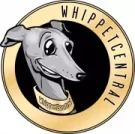A blue brindle whippet is a dog characterised by its lighter base coat and distinctive bluish coloured brindle stripes or streaks on its body.
This ‘blue’ is caused by a dilute gene which causes the typical black brindle to become ‘washed out’ or ‘diluted’ to a more greyish, blueish, icy hue.
This particular colour in a whippet is rare and special, and as well as that, it is quite difficult to achieve. Both of the whippet parents must have this dilute gene and be able to pass it on to make it possible for their offspring to become blue brindle.
However, not all puppies in the litter will obtain this gene and be born that colour.
Whippets are a breed that can have almost every combination of colours possible on a dog, and they have many different markings and patterns that come with them.
These dogs commonly have one solid colour of coat with white patches in many places on their body. Sometimes they can be tricolour, meaning they are a combination of three different colours. Other times they can be brindle.
A brindle Whippet will usually have a base colour, and stripes all across its body that appear as dark or black in colour. However, there are also Whippets, less frequently encountered, that are blue brindle.
Find out what colour exactly is this blue brindle, is it a rare Whippet variation, and how can you recognise if a Whippet is, in fact, blue brindle?
What Colour Is Blue Brindle?
Blue brindle on a Whippet is usually a colour of a gray shade, referred to as ‘blue’.
This shade known as ‘blue’ can range from either a silver, cool toned, icy, or a metal gray to a more ‘washed out’ black. It is a distinct colour found on many breeds of dogs.
It may seem like a blueish hue, but it is not a typical blue shade that is customarily the colour of the sky or the colour of the ocean – or even a navy or dark blue.
The blue is found on the brindle stripes or markings on a Whippet. It will most often be a darker colour than the rest of its body, which may be a soft hue like a cream, fawn, tan, or white.
Are Blue Brindle Whippets Rare?
Blue brindle Whippets are indeed rare. This particular coat pattern is not as commonly seen on Whippets as the dark or black brindle coat pattern.
In fact, all brindle Whippet coat patterns are rare, but the blue brindle pattern is especially rare.
The blue brindle coat pattern in Whippets can only be achieved genetically, namely, due to a genetic mutation.
How To Spot A Blue Brindle Whippet
A blue brindle Whippet will have a short haired coat, typical of the breed, with a blue brindle coat pattern that is often best described by people as streaky, striped, tiger-striped, or ‘creepy’.
The stripes will be present on his paws, tail, and ears, and they will be running down all across his body. These stripes are always very thin and irregular.
These brindle stripes will not be of an intense and striking blue colour, but rather a mild, blueish, cool, icy tinted gray.
A blue brindle Whippet sometimes may have a blue mask on his face or a blue muzzle, and a blue tint on his ears, the tip of his tail, and on his paws.
Other times, a blue brindle Whippet will have a white muzzle and a streak of white running up his forehead, or just the streak, running from the edge of his nose.
He may also have a white underbelly, paws, tip of the tail, and neck or collar, all the way round. As well as that, he may additionally have other patches of white on his body, or various streaks, spots, or blazes of white.
However, a blue brindle Whippet can always be spotted and identified due to its specific blueish stripes against a lighter base coat.
This lighter colour can be a range of different colours, but it usually is (almost always) never darker in any way than the brindle markings of the Whippet.
If the base coat is of a darker colour than the brindle markings, it will be referred to as reverse brindle.
The base coat colour of a blue brindle Whippet includes various shades of cream, tan, fawn, light gray, white, or pale.
Seen less often on a blue brindle Whippet would be a richer colour of base coat, like for instance an orange, a red, a chestnut, a mahogany, or a brown, with blue brindle markings.
If the base coat was indeed a darker shade than the brindle markings – so a red or orange tone base coat for instance – the Whippet would then be called a reverse brindle.
The eyes of a blue brindle Whippet will most often be brown or dark, but even sometimes blue.
More About Blue Brindle Whippets
Blue brindle Whippets can only occur as a genetic mutation, and this particular pattern and colour is rarer than all other Whippet markings.
It is also more difficult to achieve this blue brindle Whippet coat pattern than all other coat patterns seen in this breed.
This specific blue brindle colour occurs only due to a dilute gene that makes the more commonly seen black brindle markings a ‘washed out’ or ‘diluted black’ hue, which appears blueish, and is called ‘blue brindle’.
To be born as a blue brindle, a Whippet puppy must have received two copies of the dilute gene.
Both the mother and the father Whippet must possess and be able to pass on this dilute gene to their offspring to be able to have the possibility of achieving a blue brindle Whippet puppy.
However, even if both mother and father have the dilute genes, it does not mean that all of the puppies will be blue brindle.
For instance, in a litter of five Whippet puppies, only one, two, three, or four out of them could be born blue brindle, because these particular puppies had received two copies of the dilute gene by chance.
A puppy that is born to two parents with the dilute gene may be of any colour or any coat pattern if it has only received one copy of the dilute gene.
But as a result of this one dilute gene they now possess, they still will be able to possibly have a blue brindle or blue fawn with another dog partner that also has the dilute gene.
A Whippet does not have to be blue brindle to have blue brindle puppies – as long as he has the dilute gene, and his partner has it too, the puppies could be born blue brindle of colour.
Two blue brindle Whippets will definitely have SOME puppies that will inherit their blue colour markings. Yet, they could still have other puppies of different colours in the same litter.
Currently, all blue colour variations of Whippets are recognised by the American Kennel Club (AKC), including blue fawn and blue brindle. Blue merle, however, is not an accepted colour in these dogs.
As a result, you will never see a blue merle Whippet that is purebred.
Other Considerations
Even though Whippets are a generally healthy type of dog, being of a diluted colour such as the blue brindle colour could make them more susceptible to an illness called Colour Dilution Alopecia.
This is a skin condition which is genetically inherited, and it will cause the hair of your Whippet to fall out completely and never grow back.
Symptoms can include hair thinning and hair becoming dry, brittle, and prone to breaking. It can also result in patchy hair loss as well as dry, flaky, itchy skin, sometimes even infected or with bumps on the surface.
Some blue brindle Whippet individuals that sadly are diagnosed with this skin condition will need to receive treatment in the form of special shampoos, as well as soothing and moisturising ointments, rinses, and creams applied topically.
Antibiotics and certain supplements such as Vitamin A capsules and essential fatty acid capsules can also help.
Unfortunately, this condition cannot be cured permanently, only managed, and prevented from further getting worse, by helping to moisturise and nourish the skin and combat the flaking.
Final Thoughts
Blue brindle is a rare and very beautiful colour variation of the Whippet caused by a dilute gene.
A Whippet puppy must have received a copy each of the dilute gene from both of his parents to be born this rare blue brindle.
However, even a Whippet puppy of another colour will be able to have blue brindle puppies if it has received one copy at least of the dilute gene, and the other parent also has one copy of this gene.
The blue brindle colour marking in Whippets could hold the possibility of an increased chance of developing colour Diluted Alopecia.
Nonetheless, it is not likely for this skin condition to occur in your blue brindle Whippet, because it a rather uncommon illness, so there is low chance that your dog will ever develop it in their lifetime.
Other Popular Posts
- What Is A Blue Whippet?
- Can Whippets Have Blue Eyes?
- What Is A Whippet Dog?
- Living With A Whippet: What’s It Like?
- Whippet History: A Detailed Overview

Hello. I’m Luke- the founder of WhippetCentral. I’m somewhat of a whippet nut and have been for most of my life. In that time, I’ve owned and raised numerous whippets. Bonnie is my latest girl; she is currently eight years old and keeps me very busy! Understanding the need for whippet-specific content, I decided to create this blog to share what I have learned and to share my expertise regarding owning and raising whippets – the right way!
